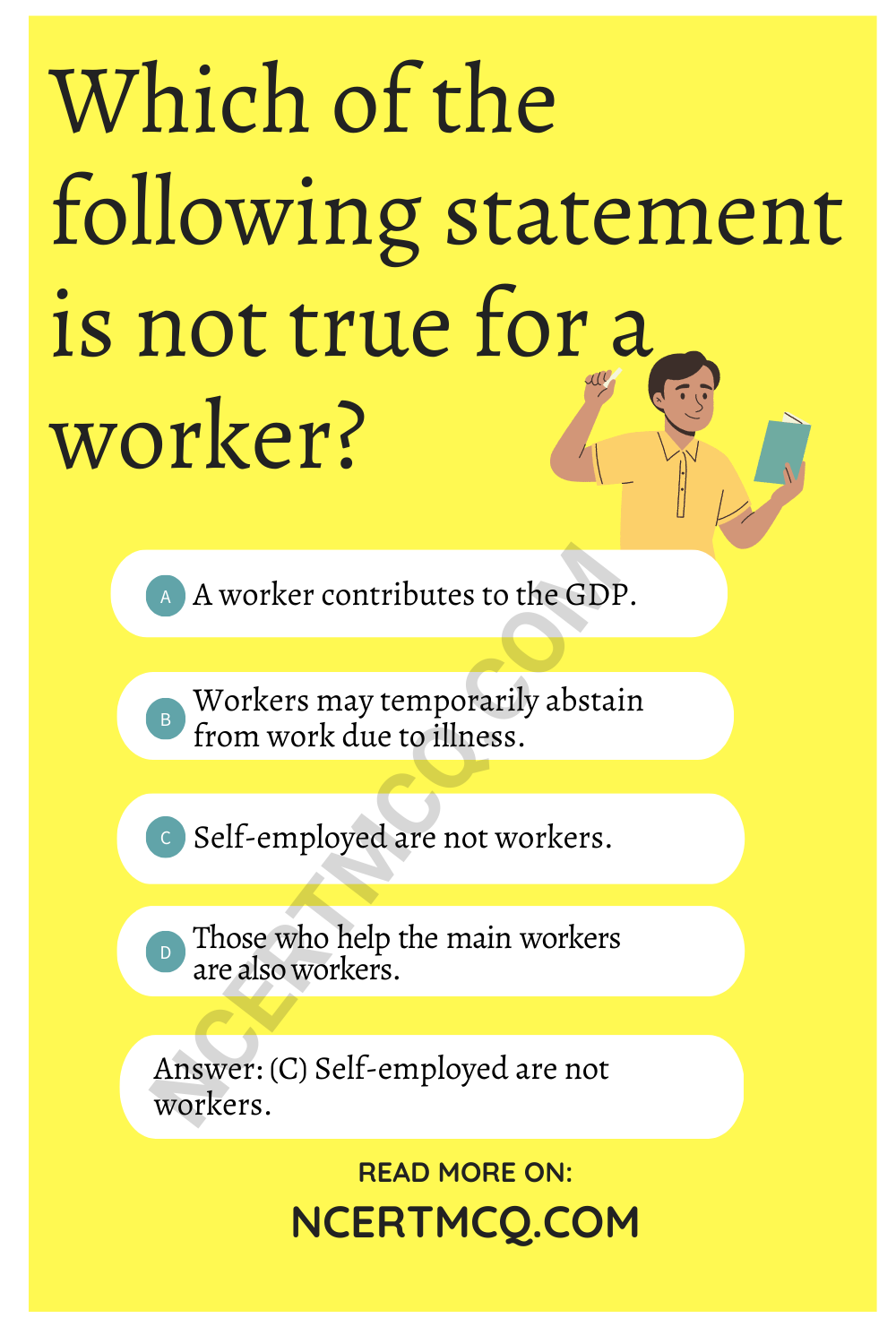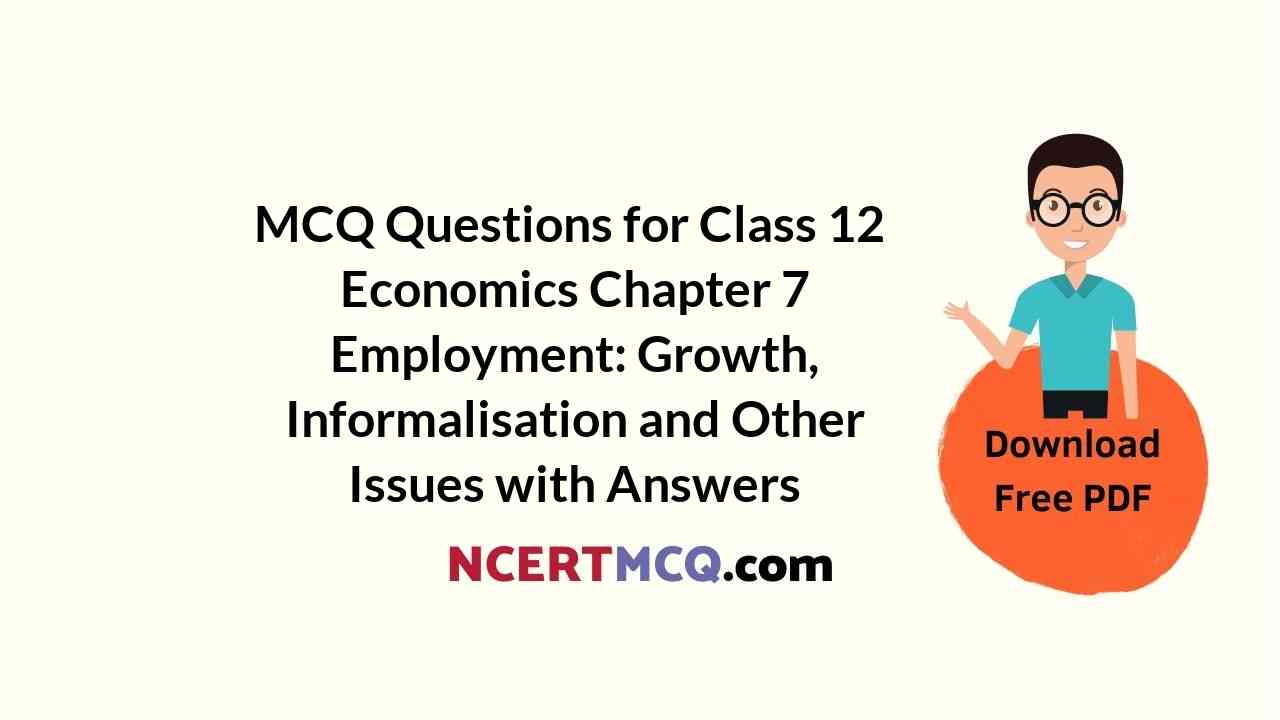Check the below NCERT MCQ Questions for Class 12 Economics Chapter 7 Employment: Growth, Informalisation and Other Issues with Answers Pdf free download. MCQ Questions for Class 12 Economics with Answers were prepared based on the latest exam pattern. We have provided Employment: Growth, Informalisation and Other Issues Class 12 Economics MCQs Questions with Answers to help students understand the concept very well.
Class 12 Economics Chapter 7 Employment: Growth, Informalisation and Other Issues MCQ With Answers
Economics Class 12 Chapter 7 MCQs On Employment: Growth, Informalisation and Other Issues
I. Choose the correct alternative.
Employment Growth, Informalisation And Other Issues MCQs Question 1.
Which of the following statement is not true for a worker?
(A) A worker contributes to the GDP.
(B) Workers may temporarily abstain from work due to illness.
(C) Self-employed are not workers.
(D) Those who help the main workers are also workers.
Answer
Answer: (C) Self-employed are not workers.

Question 2.
What is the distribution of the workforce in rural and urban areas?
(A) 75 : 25
(B) 60 : 40
(C) 50 : 50
(D) 40 : 60
Answer
Answer: (A) 75 : 25
Question 3.
Which of the following is the correct definition of self-employed?
(A) Not able to find jobs during some months of the year
(B) Own and operate their own enterprises
(C) Receive wages on a regular basis by the employer
(D) Casually engaged in other individuals enterprises
Answer
Answer: (B) Own and operate their own enterprises
Question 4.
What percent of urban workers are casual labourers?
(A) 54 percent
(B) 41 percent
(C) 39 percent
(D) 18 percent
Answer
Answer: (D) 18 percent
Question 5.
Which of the following workers is a regular salaried employee?
(A) Owner of a saloon
(B) Rickshaw puller
(C) Cashier in State Bank of India
(D) Vegetable vendor
Answer
Answer: (C) Cashier in State Bank of India
Question 6.
Which of the following is a primary sector activity?
(A) Mining and Quarrying
(B) Construction
(C) Trade
(D) Transport and Storage
Answer
Answer: (A) Mining and Quarrying
Question 7.
What proportion of the urban workforce is engaged in the secondary sector?
(A) Half
(B) One-third
(C) One-fourth
(D) One-fifth
Answer
Answer: (B) One-third
Question 8.
What was the average rate of growth of employment during 1950-2010?
(A) 1 percent
(B) 2 percent
(C) 5 percent
(D) 10 percent
Answer
Answer: (B) 2 percent
Question 9.
Which of the following is not a feature of organised sector?
(A) Job Security
(B) Social security benefits
(C) Irregular payment
(D) Fixed working hours
Answer
Answer: (C) Irregular payment
Question 10.
Which of the following is not an employment generation programme?
(A) Rural Employment Generation Programme (REGP)
(B) Prime Minister’s Rozgar Yojana (PMRY)
(C) National Food for Work Programme (NFWP)
(D) Valmiki Ambedkar Awas Yojana
Answer
Answer: (D) Valmiki Ambedkar Awas Yojana

II. Fill in the blanks with the correct answer.
Question 1.
Economic activities contribute to the ________ of the country.
Answer
Answer: GDP
Question 2.
Worker-population ratio analyses the situation of ______ in the country.
Answer
Answer: employment
Question 3.
Activities performed by women for the household are not recognized as ______ work.
Answer
Answer: productive
Question 4.
Workers who own and operate an enterprise to earn their livelihood are known as ________
Answer
Answer: self-employed
Question 5.
Among regular salaried employment, ___________ workers are found to be so engaged in greater proportion.
Answer
Answer: male
Question 6.
Enterprises in _______ areas require workers on a regular basis.
Answer
Answer: urban
Question 7.
The ________ sector gives employment to about one-third of the urban workforce.
Answer
Answer: secondary
Question 8.
______ sector covers those enterprises or places of work where the terms of employment are regular and therefore, people have assured work.
Answer
Answer: Organised
Question 9.
In _______ unemployment, people are not able to find jobs during some months of the year.
Answer
Answer: seasonal
Question 10.
NREGA 2005 promises ________ of guaranteed wage employment to all rural households who volunteer to do unskilled manual work.
Answer
Answer: 100 days
III. State whether the following statements are true or false.
Question 1.
Workers do not include those who help the main workers in their activities.
Answer
Answer: False
Question 2.
Urban people have a variety of employment opportunities.
Answer
Answer: True
Question 3.
Self-employed and casual wage labourers are found more in rural areas.
Answer
Answer: True
Question 4.
Casual wage work is the major source for both men and women.
Answer
Answer: False
Question 5.
In the course of the economic development of a country, workers migrate from rural to urban areas.
Answer
Answer: True
Question 6.
There has hardly been any change in the distribution of the workforce across various industries since the 1970s.
Answer
Answer: False
Question 7.
The Indian economy has been able to produce more goods and services due to growth in employment opportunities.
Answer
Answer: False
Question 8.
Employment is not secure in organised sector.
Answer
Answer: False
Question 9.
The Indian government has initiated the modernisation of informal sector enterprises and the provision of social security measures to informal sector workers.
Answer
Answer: True
Question 10.
Newly emerging jobs are found mostly in the service sector.
Answer
Answer: True
IV. Match the following.
Question 1.
| Column-I | Column-II |
| 1. Rural unemployment | (A) Educated unemployment |
| 2. Urban unemployment | (B) Cyclical unemployment |
| 3. Participation rate | (C) Disguised unemployment |
| 4. Number of persons unemployed | (D) \(\frac{\text { Workforce }}{\text { Total population }} \times 100\) |
| 5. Unemployment due to economic fluctuations | (E) Labour force – workforce |
Answer
Answer:
| Column-I | Column-II |
| 1. Rural unemployment | (C) Disguised unemployment |
| 2. Urban unemployment | (A) Educated unemployment |
| 3. Participation rate | (D) \(\frac{\text { Workforce }}{\text { Total population }} \times 100\) |
| 4. Number of persons unemployed | (E) Labour force – workforce |
| 5. Unemployment due to economic fluctuations | (B) Cyclical unemployment |
We hope the given NCERT MCQ Questions for Class 12 Economics Chapter 7 Employment: Growth, Informalisation and Other Issues with Answers Pdf free download will help you. If you have any queries regarding CBSE Class 12 Economics Employment: Growth, Informalisation and Other Issues MCQs Multiple Choice Questions with Answers, drop a comment below and we will get back to you soon.
Class 12 Economics Indian Economic Development with Answers MCQ:
- Indian Economy on the Eve of Independence Class 12 MCQ
- Indian Economy 1950-1990 Class 12 MCQ Questions
- Liberalisation, Privatisation and Globalisation: An Appraisal Class 12 MCQ
- Poverty Class 12 MCQ
- Human Capital Formation in India Class 12 MCQ
- Rural Development Class 12 MCQ
- Employment: Growth, Informalisation and Other Issues Class 12 MCQ
- Infrastructure Class 12 MCQ
- Environment and Sustainable Development Class 12 MCQ
- Comparative Development Experiences of India and its Neighbours Class 12 MCQ
